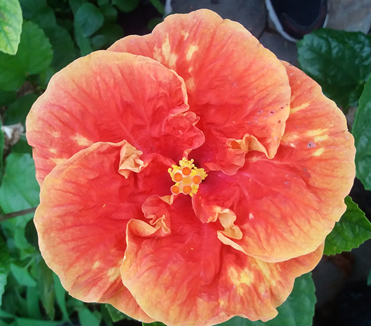
Diversity Analysis of 15 Hibiscus Accession Based on RAPD Marker
Miranda Ferwita Sari(1*), Aziz Purwantoro(2)
(1) Faculty of Agriculture, Universitas Gadjah Mada, Yogyakarta
(2) Faculty of Agriculture, Universitas Gadjah Mada, Yogyakarta
(*) Corresponding Author
Abstract
Genus Hibiscus consist of 300 species in tropical and subtropical regions. Indonesia has many species of Hibiscus genus such as Hibiscus rosa-sinensis, kenaf, rosella, waru, sharon, and others. These species have similar flower morphology despite their different benefits. Flower morphology can be use as morphological marker characters to identify the genetic relationship in one genus of Hibiscus. However, morphological markers are less accurate because they are strongly influenced by the environment, requiring quite amount of time, and showing limited and inconsistent diversity. These limitations make researcher chooses molecular markers that are considered more accurate because the material used is plant DNA. One of the most used molecular marker is Random Amplified Polymorphic DNA (RAPD). This study used DNA extraction from the leaf of 15 Hibiscus genus. The next steps were DNA quantification, temperature and primer optimization, DNA amplification with PCR, electrophoresis with agarose gel, and data analysis. The result showed 10 primers operon used for Hibiscus to produce many polymorphic bands. Analysis result showed a high diversity in control population (Hibiscus cannabinus (K1), Hibiscus sabdariffa (K2) Hibiscus mutabilis (K3), Hibiscus syriacus (K4), Hibiscus schizopetalus (K5)) while in Hibiscus rosa-sinensis, the diversity was low especially on the genotypes of flowers with the same color. Molecular marker is a right way to identify the diversity in a population. Control group which consist of Hibiscus cannabinus, Hibiscus sabdariffa, Hibiscus mutabilis, Hibiscus syriacus and Hibiscus schizopetalus has high heterozygosity means control group has high diversity. From the PCA result, grouping in control plants is based on their age (perennial and annual), while in Hibiscus rosa-sinensis the grouping is based on the flowers color. Hibiscus rosa-sinensis is cross pollinated plants caused the position stigma higher than anthers, its prooved by this experiment that varians within population Hibiscus rosa-sinensis higher than among population.
Keywords
Full Text:
PDFReferences
Akpan, G.A. 2006. Hibiscus. In: Anderson, N.O. (ed.) Flower Breeding and Genetics: Issues, Challenges and Opportunities for the 21st Century. Springer, Dordrecht.
Doyle, J. and Doyle, J.L. (1990) Isolation of Plant DNA from Fresh Tissue. Focus, 12, 13-15.
Hammad, Ibtisam. 2009. Genetic variation among Hibiscus rosa-sinensis (Malvaceae) of different flower colors using Issr and Isozymes. Australian Journal of Basic and Applied Sciences 3(1): 113-125.
Hamrick J.L., M.J.W. Godt & S.L. Sherman-Broyles. 1992. Factors influencing levels of genetic diversity in woody plant species. New Forests 6 : 95-124.
Harvey, Geoff. 2004. Hibiscus Hybridization guide Part 3: Applied genetic. http://www.internationalhibiscussociety.org/HI17_file/hiv1n171-2.html. accessed in 16 February 2017.
Kadve, S., M. Yadav and A. Tiwari. 2012. Genetic analysis on hibiscus species by using RAPD markers. International Journal of Biomedical and Advance Research 3(6): 473-485.
Kuligowska, K., H. Lutken, B. Christensen and R. Muller. 2016. Interspecific hybridization among cultivars of hardy Hibiscus species section Muenchhusia. Breeding Science 66: 300-308.
Patel, R., A. Patel, D. Vaghasiya, and A. Nagee. 2012. Elucidation of genetic diversity among five cultivars of Hibiscus rosa-sinensis using single primer amplification reaction (Spar). IOSR Journal of Pharmacy and Biological Sciences 1: 15-19.
Pekamwar, S.S., T.M. Kalyankar and A.C. Jadhav. 2013. Hibiscus rosa-sinensis: a review in ornamental plant. World Journal of Pharmacy and Pharmaceutical Science 2(6): 4719-4727.
Pereira D.A., R.X. Correa & A.C. Oliveira. 2015. Molecular genetic diversity and differentiation of populations of ‘somnus’ passion fruit trees (Passiflora setacea DC) : implications for conservation and pre-breeding. Biochemical Systematics and Ecology 59 : 12-21.
Prasad M.P. 2014. Molecular characterization and genetic diversity determination of Hibiscus species using RAPD molecular markers. Asian Journal of Plant Science and Research 4(3): 50-56.
William, J.G.K., A.R. Kubelik, K.J. Livak, J.A. Rafalski, and S.V. Tingey. 1990. DNA Polymorphism Amplified by arbitrary Primers are useful as genetic marker. Nucleic Acids Research 18: 6531-6535.
Zulfahmi. 2013. Penanda DNA untuk analisis genetik tanaman. Jurnal Agroteknologi 3(2): 41-52.
Article Metrics
Refbacks
- There are currently no refbacks.
Ilmu Pertanian (Agricultural Science) ISSN 0126-4214 (print), ISSN 2527-7162 (online) is published by Faculty of Agriculture Universitas Gadjah Mada collaboration with Perhimpunan Sarjana Pertanian Indonesia (PISPI) and licensed under a Creative Commons Attribution-ShareAlike 4.0 International License.













